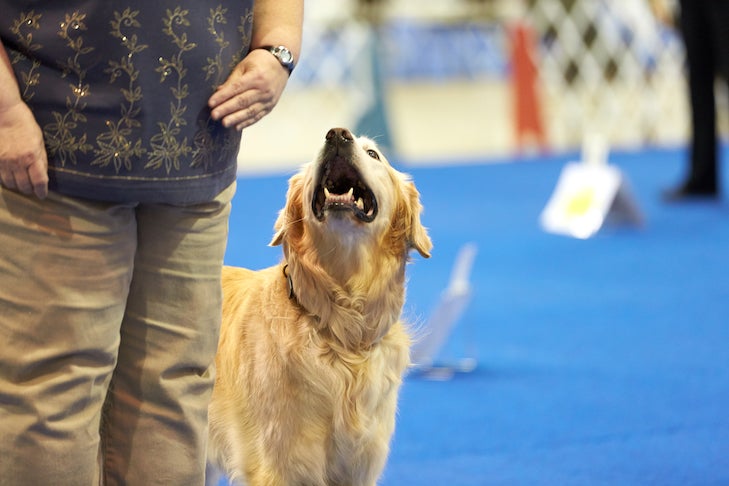
Have you ever wondered why your dog’s face is so irresistible? A new study in the Proceedings of the National Academy of Sciences (PNAS) says that dogs’ facial features – in particular, “puppy dog eyes” – may have evolved based on human preference.
When breeding began with wolves to create domestic dogs, humans bred with the purpose of completing tasks such as farming, pulling sleds across frigid temperatures, or keeping a group of nomads safe. For example, the Greyhound types were bred to chase prey at alarmingly fast speeds and Mastiff types were bred as protectors. But were dogs subconsciously bred to be cute as well?
It’s All in the Eyes
As humans adapted to their surroundings, dogs followed. Eventually, dogs became more sophisticated as they were bred to meet the lifestyles of their owners.
The PNAS study suggests that through the domestication of dogs from wolves, their facial muscle transformed to meet communication standards of humans. The muscle responsible for raising the inner eyebrow is uniformly present across domesticated dogs but not in wolves.
“The most remarkable among dogs’ behavioral adaptations, as a result of selection during domestication, is their ability to read and use human communication in ways that other animals cannot,” the PNAS study states.
Analyzed behavioral data also suggests that dogs raise their inner eyebrows more frequently and with a higher intensity than wolves do. The researchers believe dogs with these “puppy dog eyes” were preferential to humans and therefore more highly selected.

Facial musculature in the wolf and dog with differences in anatomy highlighted in red. Image courtesy of Tim D. Smith (Cambridge University Press, Cambridge, UK).
The Impact on Dog Sports
Though a variety of breeds demonstrate different facial expressions, the study suggests that eyebrow movement is uniform across breeds. We spoke with Anne Burrows, an author of the study and professor of anatomy at Duquesne University.
“We conducted a study about five years ago that explored dogs in a shelter. The dogs who make this movement are adopted more quickly than dogs that don’t.” She explains that dogs bred to be companion dogs, such as Cavalier King Charles Spaniels, may make this facial movement more frequently.
So what impact does this have on activities dogs and humans do together, such as dog sports? For starters, eye contact between dogs and humans is imperative for social interaction. Canines use this communication when they cannot solve problems alone. Eye contact allows dogs to receive communication that is directed or relevant to them.
Think of AKC sports — Rally, Agility, Obedience and many more. These events encompass specific training and communication where it is crucial to have a special bond of your canine. It’s not just the canine that needs to receive communication — humans are influenced too.
“You would think there would be some impact [to dog sport success], because people are influenced by communication,” Burrows says. “We could certainly test the successes and how [dog’s facial expressions] influence sports.”
In these events, communication is necessary, as owners and canines work together through courses. Based on the research of PNAS, some speculate a handler may prefer working with a dog who is more expressive, allowing for better communication and higher success rates in the sport.

Creating a Bond
The PNAS study also suggests that humans prefer dogs that show paedomorphic (infant-like) anatomical features.
These features can consist of a bigger forehead, larger eyes, and more. This observation came after people were asked to select pictures presenting dog or cat faces that had more or less paedomorphic features.
“The movement makes the eyes appear bigger, hence more infant-like and potentially more appealing,” the study adds. This expression resembles sadness, and for humans, this triggers a nurturing response.
Imagine a dog being selected from a shelter. The study highlights that dogs in this situation may produce this facial movement more frequently, potentially giving them a selection advantage.
The video demonstrates the ability of dogs to move their inner eyebrow upward, making them more appealing to humans.
Can You Deny Those Puppy Dog Eyes?
Through history, one thing has remained constant – it’s hard to say no to “puppy dog eyes”. Dogs have evolved to fit the needs of a task, their owner, their surroundings and humans are naturally drawn to a “cute” face.
The study notes that “all domestic dogs routinely possessed this muscle, except for the Siberian Husky specimen, which interestingly belongs to more ancient dog breeds, more closely related to wolves than many other breeds.” In the study, the group only had one Siberian Husky to research, so it is difficult to draw conclusions.
“Huskies communicate with vocalization, they almost sound like human infants,” Burrows says. “I feel that they vocalize a lot more among other ancient breeds. I’m really dying to know if any other ancient breeds follow this technique.”
Even Burrows admits she can’t resist her own dog when she sees her puppy dog eyes. “I can’t say no, it’s not possible. If I see my dog making that face, I drop everything I’m doing to try and find out what she needs or what she wants. Usually, it involves me giving her a biscuit.”

